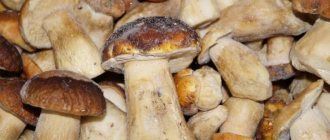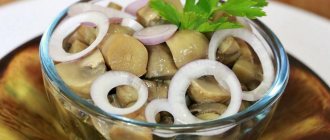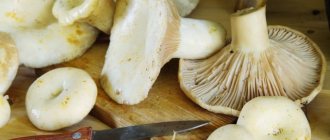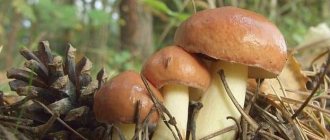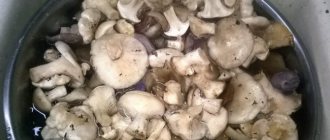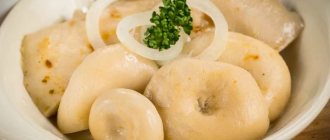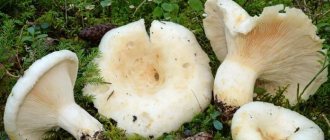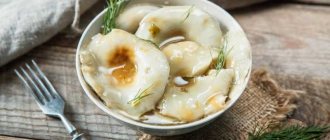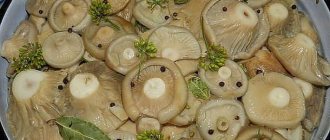Milk mushroom is not a simple mushroom. On the one hand, it belongs to the Milky family, which characterizes it by the presence of bitter milk, which complicates culinary processing. On the other hand, it has one of the densest structures among edible mushrooms, which makes mushroom pickers want to send excess forest trophies to the freezer. Considering this contradictory nature of the mushroom, many are wondering how to freeze milk mushrooms for the winter in order to get rid of the bitterness and maintain their original elasticity. As practice shows, if there is a desire, there are plenty of ways.
Is it possible to freeze milk mushrooms for the winter?
Milk mushroom is a popular mushroom, in demand among mushroom pickers. To preserve it for the winter, freezing is an option. In this case, it will lose its hard structure and will be soft after defrosting. Can be used as a semi-finished product, additive or filling. This product can be stored for up to six months. The product must be defrosted during cooking.
Is it possible to freeze salted milk mushrooms? Certainly! To prepare, squeeze the mushrooms a little using a sieve to remove as much liquid as possible. Next, put into containers or bags and freeze. To speed up the process, mushrooms should be rinsed from brine, you can use boiled water, dry and freeze.
This variety of mushrooms can be frozen in different ways. For example, boiled, fried or fresh. Before freezing, raw milk mushrooms are processed (boiled or fried) to destroy harmful microorganisms, remove bitter juice and reduce volume. You need to process the milk mushrooms on the day of collection or the day after collection. The fresher the mushroom, the better.
After this, just sort the mushrooms and leave them in the freezer. Once frozen milk mushrooms can no longer be subjected to this process, since the beneficial properties of the mushrooms are lost and they become useless.
| Boil | Fry |
| 1. Place raw mushrooms in a frying pan |
| 2. Fry (can be in vegetable oil) |
| 3. Fry for 20-30 minutes |
| 4. Keep in the frying pan until the moisture has evaporated as much as possible |
| 5. Let them cool |
| 6. Packaging |
| 7. Freeze |
You can also boil milk mushrooms in salted water, cook for 5-10 minutes, then follow the instructions.
Freezing methods at home
Freezing methods completely depend on the method by which the milk mushrooms were heated. They can be boiled or fried. Storage in the freezer will be long and reliable. Then forest gifts can become an additive to marinades, borscht, soups and salads. Proper processing will remove bitterness, so in the future they will be able to delight you with an exquisite taste.
Frozen boiled mushrooms
Using this method, it is good to freeze fruits in small portions in plastic bags. It is also not advisable to re-freeze after the milk mushrooms have already been thawed.
What you will need:
- freshly picked mushrooms;
- a pinch of salt;
- lemon acid.
How to freeze: prepared milk mushrooms should be rinsed well under running water, cut into small pieces and placed in a container for boiling. Add salt to boiling water and boil the main component for 7 minutes. Strain and cool the product in a container with cool liquid. Dry, cover in one layer and freeze. Due to the high temperature, the protein folds, which contributes to a better structure of the main component.
Frozen dry milk mushrooms for the winter
The most common method is freezing dry forest products. With this freezing method, the taste qualities are practically not lost, and the structure does not change. Ingredients:
- 1 kilogram of milk mushrooms;
- greens - optional;
- a pinch of salt;
- 3 tablespoons of vegetable oil.
How to freeze: place the dry preparation in a deep container, add vegetable oil and simmer the mixture until soft. Then add a spoonful of white wine, sprinkle with spices and add herbs if desired. Then you need to cool and freeze.
Fried
Freezing forest products is another method that reduces preparation time and effort. This recipe describes frying the main component with vegetable oil and seasonings. The second option involves frying without vegetable oil - the mushrooms can be fried in their own juice. Ingredients:
- fresh forest product;
- a little salt;
- vegetable oil.
How to freeze: rinse the prepared ingredient thoroughly and chop it. Add salt to the cooking container and add milk mushrooms. Boil them for 10 minutes. And only after this the dried fruits can be fried in a frying pan. The duration of the process is half an hour. Then the main component must cool. During frying, milk mushrooms acquire a special aroma and pronounced taste. Transfer them to bags or containers and freeze them.
Advice! Any liquid that is quickly frozen will expand as a result. Therefore, you should not add a lot of vegetable oil.
Scalded
When heated, the bitterness of prepared fruits is completely eliminated, in contrast to the cold harvesting method. Before freezing milk mushrooms, you need to scald them with boiling water. However, even in this case it is impossible to do without soaking the forest inhabitants. This is necessary to remove contaminants. Scalded mushrooms should be cut into medium pieces, placed in containers and frozen.
See also
How to properly freeze porcini mushrooms for the winter, the best cooking recipes
Read
Stewed
Freezing is also possible for stewed forest products. This recipe involves freezing along with the liquid. However, this method is suitable if you plan to prepare julienne or puree soup in the future. Ingredients:
- prepared milk mushrooms;
- dessert spoon of salt;
- 100 milliliters of water;
- spices.
How to freeze: the fruits are thoroughly washed to remove dirt and other impurities. Then pour some liquid into the cooking container and salt it. Boil the contents for 15 minutes. The first broth must be poured out and new water added instead. Pour spices as desired, boiled water into the cooking container and simmer with the lid closed for another 10 minutes.
If necessary, you can diversify the preparation and add sautéed carrots or onions. Then the preparations need to be cooled. Then transfer to containers and freeze. This preparation for the winter is stored for no more than three months.
Freezing cold-salted milk mushrooms
Salting large quantities of collected forest supplies is an excellent form of preservation. However, in some cases, the temperature does not allow storing them in any convenient place. In order not to lose winter preparations and save salted preserves, you can resort to the freezing method. The main component will be soft and suitable for making soups or pates.
How to freeze: pour the brine from canned containers, squeeze out the main ingredient and remove excess moisture. Whole forest products or chopped ones are suitable for freezing. Place in suitable containers or plastic bags. Send for freezing.
Freezing fresh
Fresh forest finds are also suitable for freezing. Raw milk mushrooms retain a maximum of beneficial minerals and vitamins. Before placing them in the freezer, you need to soak them in a container of water to remove bitterness. After cleaning the component, trim and chop. Damaged ones are not suitable for freezing. Place in suitable containers or bags and freeze.
Basic storage rules
Whatever salting method is chosen, there is one general rule: salted mushrooms should be stored in a place
- protected from light,
- with low humidity,
- at a temperature not exceeding +6°C,
- and not falling below 0°C.
If the temperature drops below zero, the products will freeze, become brittle and lose their taste. At temperatures above +6°C, pickles begin to sour, after which it will become unsafe to eat them.
An unusual storage option without brine
Some housewives prefer to store salted mushrooms without brine. It was noticed that fat and oily film do not leave mold any chance. Mushrooms prepared using this option will never become moldy.
The essence of the method is as follows:
- Mushrooms are salted in the usual, familiar way.
- A mandatory step is to keep the pickled mushrooms (in brine) in the refrigerator for at least 1 week.
- After 7 days, all the liquid is drained, and vegetable oil is poured into the container instead.
- To consume, you just need to drain the oil and enjoy the excellent taste of mushrooms.
For storage, choose a dry, cool and always dark place. Under the influence of light, the process of fat breakdown occurs, and this negatively affects the taste, rancid notes appear.
Salted mushrooms in oil do not lose their properties for 6 months.
Dishes that can be prepared from frozen milk mushrooms
More than one or two dishes are prepared from frozen milk mushrooms, but the choice will depend on which method of processing the product was chosen earlier. So, you can be content with fried or stewed mushrooms as a self-sufficient dish or side dish, make a salad, julienne, cook soup (for example, Georgian) or cream soup. Frozen mushrooms are also suitable as a filling for pie or pizza.
Dry method
This method can be used when harvesting saffron milk caps and saffron nuts.
- Peel the mushrooms and wipe them with a clean cloth (do not wash them).
- Place the mushrooms in a tub in rows, sprinkle with salt and cover with canvas, press on top with pressure.
- After some time, juice should appear above the pressure.
- There is no need to put spices in these mushrooms, as they perfectly retain their natural taste.
- In 10 days the workpiece will be ready.
What to do if mold has already appeared
Considering that mold is omnipresent, experienced housewives know how to deal with its manifestations. You shouldn’t throw away mushrooms, but leaving them to chance is not the right decision, since both the taste and smell of the delicacy will suffer. Therefore, as soon as you notice the slightest mold, you need to take a number of measures:
- Find out the extent of the damage.
- If mold is visible only on the surface of the mushrooms and brine and has not penetrated deeper, then carefully remove the top layer of mushrooms and drain the old brine, wash the rest, bring to a boil, and drain the water. The jars are sterilized again, into which the mushrooms are then placed, sprinkling the layers with salt (the mushrooms will not take excess) and filled with a new, non-boiling saline solution.
- If the mold has penetrated deeply and there is a persistent musty odor, no matter what you do, it will not go away. Therefore, without regret, it is better to throw everything away completely. Remember that if you eat mushrooms with mold, you risk getting poisoned.
- Add spices: cloves of garlic, sprigs of dill with seeds, horseradish leaves.
- Disinfect the weight, flap, wooden circle or plate that is placed directly on the salted mushrooms. To do this, rinse them thoroughly in warm water, then scald with boiling water. After that, install everything in its place.
- Store and maintain the temperature range from 4 to 6°C.
- Every week after storage, carry out the following sequence of actions:
- remove the weight, plate or wooden circle and drain the top brine;
- pour clean water and drain again;
- Be sure to wipe the top edges of the dishes. To do this, you can use a clean cloth soaked in vinegar;
- pour fresh saline solution (1 tablespoon of salt per 1 liter of water) and place the weight in place, having disinfected it in advance and what it stands on.
What are the benefits of milk mushrooms?
Due to their peculiar bitterness, some may consider these mushrooms to be poisonous. However, this is not at all true: milk mushrooms are classified as russula. This forest dweller is especially famous for its protein - its content is significantly higher than the amount of protein in beef. Also, for the body’s immune defense, ascorbic acid, which is abundant in these mushrooms, will be extremely useful. Milk milk is a fairly nutritious product, so even a small consumption can satisfy you for a long time.
It would be a good idea to consume this mushroom for people with diabetes, as it will not increase blood glucose levels. People whose milk mushrooms are not the last place in their diet are less susceptible to mental disorders and depression.
Toxins and excess fluid are removed from the body due to the diuretic effect of these products. And also some anti-tuberculosis drugs are produced based on this fungus.
How to freeze milk mushrooms for the winter, and most importantly, is it worth it?
Milk mushroom is not a simple mushroom. On the one hand, it belongs to the Milky family, which characterizes it by the presence of bitter milk, which complicates culinary processing. On the other hand, it has one of the densest structures among edible mushrooms, which makes mushroom pickers want to send excess forest trophies to the freezer. Considering this contradictory nature of the mushroom, many are wondering how to freeze milk mushrooms for the winter in order to get rid of the bitterness and maintain their original elasticity. As practice shows, if there is a desire, there are plenty of ways.
How long to cook milk mushrooms until ready in a saucepan
In order to cook milk mushrooms correctly and so that they retain all the beneficial vitamins, micro minerals and elements, you need to follow a few tips.
The main advice is that mushrooms must be thoroughly cleaned of contaminants before cooking. But try not to damage their surface. After cleaning, the mushrooms are placed in a pan of water and there they should cook after boiling for about 20 minutes. In order not to lose the beneficial properties of milk mushrooms, you should not keep them longer than the prescribed time.
Immediately after boiling, mushrooms can be eaten or used in the preparation of other dishes. Most often, boiled milk mushrooms are used for pickling or making long-term pickles for the winter.
Cold way
This method is suitable for mushrooms that do not require pre-cooking: saffron milk caps, milk mushrooms and russula.
- Soak the cleaned and washed mushrooms for 2 days, changing the water frequently. Or soak them in salted water (dissolve 10 g of salt and 2 g of citric acid in 1 liter). Change the water at least twice a day.
- Place the mushrooms in a barrel in layers, sprinkling with salt (40-50 g of salt per 1 kg of mushrooms), caraway seeds, garlic, cherry, currant or horseradish leaves.
- Cover the top of the dish with canvas and press down with pressure.
- When the mushrooms settle and release juice, you can add new mushrooms to them.
- Take the barrels to a cool place for storage.
- After 6 days, check if there is brine in the mushrooms. If the quantity is insufficient, add saline solution (20 g of salt per 1 liter of water) or increase the load.
Why did milk mushrooms become moldy when salted?
Many experienced housewives know what to do if mold appears when pickling milk mushrooms. They strongly recommend adding 3-4 tbsp to each jar on top. l. calcined vegetable oil. This ingredient forms a greasy film on the surface that prevents mold from forming.
If the salted milk mushrooms are still covered with mold, what should you do in this case? Usually the top layer of mushrooms becomes moldy, so it is removed and thrown away. Other mushrooms are washed in cold water, sprinkled with salt and spices, and horseradish or blackcurrant leaves are placed on top. Everything is covered with a linen napkin, which must be washed periodically in hot water with the addition of soda.
If mold appears on the surface when pickling milk mushrooms, this is a natural process and you should not throw away such mushrooms. Once the mushrooms have been salted, they are covered with gauze folded in several layers. As soon as mold forms on the surface, the gauze is removed and washed in hot water.
If you haven’t inspected the pickling for a long time, and mold has penetrated the mushrooms, you need to remove a couple of layers of pickled milk mushrooms and throw them away. It will be better if the mushrooms are transferred to sterilized jars, filled with new brine and closed with tight nylon lids, which should also be boiled in advance.
Salted milk mushrooms are usually covered with white mold, which does not indicate final deterioration of the prepared product. However, there are times when black mold appears on the surface. In this case, the mushrooms are thrown away without delay or pity - such a product is mortally dangerous to human health.
If, during salting, the milk mushrooms become moldy while they were in the refrigerator, this is a big problem. In this case, the mushrooms should be disposed of without regret. There can be many reasons why mold appears in mushrooms, but not all of them may depend on you. Perhaps the fruiting bodies were already infected with this fungus, and under favorable conditions they began to reproduce.
Fresh mushrooms are sometimes stored in the refrigerator. What to do if mold appears on milk mushrooms? No matter how sorry it is, the mushrooms are thrown away, since mold is toxic to humans and causes allergic reactions and respiratory diseases. Usually on fresh mushrooms only part of the fungus is noticeable, which has pierced the inside of the mycelium.
Mold on mushrooms is a sign of spoilage from improper storage of the product. Mold usually appears where there is a lot of moisture. For example, you stored mushrooms in closed plastic bags. It is worth saying that mold can survive in difficult conditions: at high or low temperatures. Therefore, fresh mushrooms that are covered with mold spores cannot be saved by anything - neither by heat treatment nor by freezing.
Pre-treatment and preparation of the product for freezing
In this matter, it is extremely important to remember that milk mushrooms contain toxic substances that must be eliminated before further processing. Also, before freezing prepared mushrooms, heat treatment should be carried out. The need for careful processing is due to the fact that these mushrooms are considered conditionally edible - permissible for inclusion in dishes only if the necessary measures are taken. Once forest creatures have been brought home from the forest, it is not recommended to cover them tightly and place them in a cool place.
If you immediately place them in a cold place, you can significantly increase the chances of contracting botulism, since in the room, without proper access to oxygen, active reproduction of pathogenic microorganisms will begin. And therefore all mushrooms should be thoroughly washed with water. It is recommended to perform the remaining actions one by one, following the instructions of experienced mushroom pickers. This is the only way to preserve the taste qualities that are inherent in milk mushrooms.
What to do:
- Sort mushrooms. If the process of picking mushrooms was so exciting that other mushrooms were found along with the milk mushrooms, they should be sorted. Some types of mushrooms are not recommended to be stored together.
- Clean the mushrooms from any small debris. Forest gifts live in places near stumps and young trees covered with moss. There may also be anthills and other insects nearby. This process may take a long period. However, in this case, you can resort to a trick by purchasing a special brush with soft bristles.
- Finish the preparation using a knife. With this device it is necessary to clean all damaged areas, cut off the stem and worm spots. Then you can start washing the mushrooms.
The processed product should be washed under water; change the water several times. Afterwards you need to pour it into a deep container and leave it for several hours. Optimal soaking is at least two days. During this time, the forest gift will completely get rid of toxic substances. Then they can be chopped and sent to cook. The water in the pan can be lightly salted. After boiling, boil for 15 minutes.
Salting cold and hot
At home, milk mushrooms are most often preferred to be salted and pickled.
Cold pickling
To prepare cold-salted milk mushrooms, place the raw caps in containers and add spices and salt.
It is important to choose the right container:
- for salting a large number of milk mushrooms, you can use oak barrels, tubs, as well as enamel tanks; the finished mushrooms are still stored in this container, but it must be put away in a cold place (cellar, basement) a few days after storage;
- It is convenient to salt small volumes of mushrooms in enamel pans, the main thing is that it is possible to place a load on top;
- salting in jars is not recommended; mushrooms are only marinated in such containers;
- All containers must be clean and dry.
To enrich the taste, when preparing salted milk mushrooms, you need to add spices and also choose the right salt. It should be without additives, not iodized and not marine. It is better to use a large stone one.
A large amount of chopped garlic, currant leaves, horseradish, dill sprigs, and young cherry shoots are perfect as spices. All greens should be thoroughly washed and chopped if necessary.
The order of stacking mushrooms:
- A layer of salt - at least 1 cm - and a layer of spices are poured onto the bottom of the container.
- The milk mushrooms are placed on the salt with their caps down, each layer (6-8 cm) sprinkled with salt and a mixture of spices. The optimal salt consumption per 1 kg of mushrooms is 40-50 g.
- Fill the container to the top and cover with a layer of salt and herbs.
- Cover the contents with a suitable diameter wooden lid (smaller than the diameter of the container itself, so that the lid sinks into it) or a plate and place pressure on them. The top can be covered with a clean cotton cloth.
A few days after pickling, when the mushrooms give juice, you need to take them out into the cold. You can try the preparation after 7-10 days, but the full taste will appear only after 2 months.
Experts advise maintaining a temperature of +5-6°C for storing salted milk mushrooms. If they are lower, the milk mushrooms will freeze and lose both their crispy structure and taste. If they were stored at a higher temperature, they can sour, mold and become a source of dangerous diseases.
If you salt mushrooms in small containers, you can transfer them to glass jars, being careful not to disturb the structure of the caps. When transferring, be sure to pour all the brine, trying to ensure that it completely covers the mushrooms - they should not dry out. If there is not enough brine, you can prepare fresh one and add it to the top of the jar.
To store salted milk mushrooms in the refrigerator, cover the jars with plastic lids and place them on the bottom shelf of the refrigerator.
Hot salting
Long-term storage of milk mushrooms can also be ensured thanks to hot salting. With this method, before sending the mushrooms into the saline solution, they are first boiled. Prolonged soaking is not required.
Hot salting procedure:
- Peeled milk mushrooms are poured with cool water with added salt (10 g of salt per 1 liter), brought to a boil and boiled for 5-6 minutes. The liquid is drained and will no longer be useful.
- Boiled mushrooms are poured with fresh boiling water (0.5 cups per 1 kg), salt is added in the same proportion as the first time, brought to a boil again and kept on fire for 10 minutes. Add spices 3 minutes before the end of cooking.
- The mushrooms are placed in jars along with the brine, placing them as tightly as possible and pouring the brine up to the shoulders of the container.
- Salt milk mushrooms hot for at least 30 days. They can be stored in the refrigerator for 3-4 months.
Milk mushrooms can also be pickled. It’s good to pamper your family with pickles until spring, provided they are stored in the refrigerator. At room temperature, the shelf life will be reduced to 3-4 months.
Remember the main thing: the correct harvesting and storage technology guarantees safe consumption and a long service life of milk mushrooms.
Is it possible to freeze milk mushrooms?
“It is possible” or “not possible” is often determined by comparison. If there are less troublesome mushrooms, then why bother with freezing milk mushrooms? But if the “silent hunt” was very successful, and there is no place to store barrels of pickles, then freezing comes to the rescue. There are at least several reasons that make such preparation of milk mushrooms very attractive:
- if in the winter season it’s not a problem to buy imported or greenhouse vegetables, then wild mushrooms are hard to find, and artificially grown champignons and oyster mushrooms seriously lose out in real mushroom aroma and benefits;
- the dense body of the milk mushroom (some researchers associate its name with the word “heaviness”) is ideally suited for freezing for the winter: the less porous the product, the less it suffers from the expansion of frozen moisture in the voids, which destroys its structure;
- One cannot fail to mention the benefits of real milk mushrooms: its composition is rich in protein, dietary fiber and vitamins C, B1 and B2, which are perfectly preserved when frozen.
Freezing boiled milk mushrooms
Before boiling, milk mushrooms must undergo the same thorough cleaning procedure. It is best to put them in already boiling water, which will allow the protein to coagulate and harden, and the structure will be better preserved. After the second boil, it is enough to boil the mushrooms for no more than 10 minutes, after which they should be thrown into a colander and the water should be allowed to drain completely. The less moisture remains, the more elastic the product will remain after defrosting. The dried mushrooms are placed in containers, preferably with the cap down - this way they are less likely to be damaged - after which they can be frozen for the winter.
Defrosting rules
Having found out whether fresh mushrooms can be frozen, I want to find out how to defrost them. Experts say that defrosting should take place gradually, by moving boletus mushrooms from the freezer to the refrigerator overnight
. Then they should be kept for 3 hours at room temperature. After defrosting, the product must be used immediately; after re-freezing, the mushrooms will turn into a shapeless mass.
To prepare some dishes, preliminary defrosting is not required; the product is immediately used frozen. For example, when preparing first courses (soups), mushrooms are immediately thrown into boiling water and boiled until completely cooked.
During the “quiet hunting” season, many people wonder how to preserve the entire harvest of mushrooms. A great way to do this is to freeze it. You can freeze both wild mushrooms and those you purchased in a store or market. After all, everyone knows that in the summer the price of mushrooms is much lower.
Porcini mushrooms, chanterelles, honey mushrooms, boletus mushrooms, oyster mushrooms, champignons and other types of mushrooms can be frozen at home. The general principle of freezing is the same for all mushrooms.
First of all, mushrooms are sorted according to the structure of the mushroom. In this case, they distinguish:
- marsupials (truffles, morels);
- lamellar (for example, russula);
- tubular (ceps, boletus mushrooms).
It is preferable to freeze only tubular (or, in other words, spongy) mushrooms raw. The internal structure of the cap of such mushrooms is a porous surface, which, when boiled, absorbs a lot of liquid, and, as a result, the mushrooms will be watery when defrosted. If you had to boil sponge mushrooms, you should lightly squeeze them before freezing.
Lamellar types of mushrooms, such as honey mushrooms, must be boiled before freezing.
The few types of marsupial mushrooms must be boiled and thoroughly squeezed before placing them in the freezer.
How to store salted mushrooms in the freezer
For those who do not have a dry cellar, there is a great way to preserve mushrooms after pickling. We are talking about storage in the freezer.
Do this:
- After the salting stage is completed, drain the brine from the mushrooms.
- The salted mushrooms are slightly dried.
- The product is packaged in plastic bags. They try to make small packages so that one part can be used at a time.
- Salted mushrooms prepared in this way are sent to the freezer. Here they are stored for quite a long time without loss of quality characteristics.
Salted mushrooms from the freezer are immediately ready to eat, without additional processing.
Important
- Callanetics and contraindications for practicing it
- Icelandic moss: contraindications for use
- Dioscorea Caucasica: friend or foe from the Red Book?
- Bioptron device: contraindications
- Solyanka kholmovaya: uses and contraindications
- Contraindications Herbalife
- Vibration platform: contraindications and warnings
- Bodyflex and its contraindications
- Beautiful surnames for girls – 154,381 views.
- How to choose entrance doors - 114,977 views.
- What to give for a housewarming – 86,732 views.
- How to prepare for an abdominal ultrasound - 83,687 views.
- How to clean coins at home - 50,815 views.
- How to knit a tube scarf? Practical advice. – 50,257 views.
- Is it possible to get pregnant the day before your period? – 47,672 views.
- Secrets of the skill: how to quickly cook peas? – 42,862 views.
How to freeze milk mushrooms fresh in the freezer for the winter (with video)
Before freezing milk mushrooms in the freezer for the winter, we strongly recommend thermally treating the raw materials. This will save space and time in the future, since such a preparation can be immediately used to prepare any dish. Read tips on how to freeze milk mushrooms in this material.
Here are the best methods and recipes for processing mushrooms. You will learn not only how to properly freeze milk mushrooms for the winter, but also about the rules for their subsequent storage. In principle, each housewife has her own ways of freezing milk mushrooms at home. But there are also recipes that are little known but deserve to be popularized. These are the recipes and tips on how to freeze fresh milk mushrooms that are collected on this page.
The liquid formed during cooking is drained.
How long can an open jar of pickled mushrooms be stored?
After opening pickled mushrooms, they need to be eaten within a few days (the 3-day rule also works in this case). When using plastic lids, the shelf life of pickled mushrooms is reduced: in the basement up to 1.5 months, and in the refrigerator - about 3 months.
Interesting materials:
What is the difference between a designer renovation and a regular one? What is the difference between a lease and a sublease? What is the difference between fat32 and exFAT? What is the difference between coriander and cilantro? What is the difference between a carpet and a rug? What is the difference between cream cheese and cream cheese? How is turmeric different from ginger? What is the difference between mp3 and Audio CD? What is the difference between a steamer and a steam cleaner? What is the difference between professional retraining and a second higher education?

